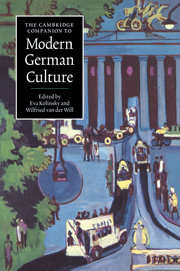Book contents
- Frontmatter
- In search of German culture: an introduction
- 1 The citizen and the state in modern Germany
- 2 German national identity
- 3 Elites and class structure
- 4 Jews in German society
- 5 Non-German minorities, women and the emergence of civil society
- 6 Critiques of culture
- 7 The functions of 'Volkskultur', mass culture and alternative culture
- 8 The development of German prose fiction
- 9 Modern German poetry
- 10 German drama, theatre and dance
- 11 Music in modern German culture
- 12 Modern German art
- 13 Modern German architecture
- 14 German cinema
- 15 The media of mass communication: the press, radio and television
- Index
14 - German cinema
Published online by Cambridge University Press: 28 May 2006
- Frontmatter
- In search of German culture: an introduction
- 1 The citizen and the state in modern Germany
- 2 German national identity
- 3 Elites and class structure
- 4 Jews in German society
- 5 Non-German minorities, women and the emergence of civil society
- 6 Critiques of culture
- 7 The functions of 'Volkskultur', mass culture and alternative culture
- 8 The development of German prose fiction
- 9 Modern German poetry
- 10 German drama, theatre and dance
- 11 Music in modern German culture
- 12 Modern German art
- 13 Modern German architecture
- 14 German cinema
- 15 The media of mass communication: the press, radio and television
- Index
Summary
The birth of film in Germany
On 1 November 1895, nearly two months before the famous Lumière screening in Paris, the brothers Max and Emil Skladanowsky showed a fifteen-minute film programme at the Berlin Wintergarten using their Bioscop, and by June of the following year the inventor and entrepreneur Oskar Messter had sold his first flicker-free projector incorporating the Maltese cross mechanism. Soon after the turn of the century Messter was experimenting with the synchronisation of film footage and gramophone records and establishing his reputation as Germany's first major film producer. Germany thus had its share of pioneers at the start of film history. However, large-scale production of narrative film was slow to develop, allowing French, Danish, Italian and American films to dominate until the First World War.
In the wake of increasingly vociferous attacks on cinema for its low moral standards and corrupting influence the term Autorenfilm (writer's film) was coined in 1913. This tag was intended to enhance the reputation of the medium through the script of a recognised author, as exemplified by Max Mack's Der Andere (The Other, 1913), a variation on the Jekyll-and-Hyde motif, written by the playwright Paul Lindau. It was during this period that leading theatre directors, including Max Reinhardt, began to work in cinema, and filmmakers, drawing creatively on the German Romantic tradition, devised special effects to stage fantastic narratives: Stellan Rye's Der Student von Prag (The Student of Prague, 1913) introduced the motif of the Doppelgänger, and Paul Wegener and Henrik Galeen's Der Golem (The Golem, 1914) drew on the cabbalistic legend of the clay man.
- Type
- Chapter
- Information
- The Cambridge Companion to Modern German Culture , pp. 302 - 321Publisher: Cambridge University PressPrint publication year: 1999



